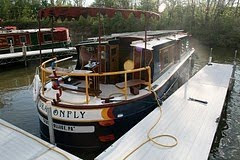 |
| Canal boaters used the steps at right when they wanted to leave their boats and shop at the lock. |
I walked the two miles out of town to check it out.
Officially, this is "Enlarged Erie Canal Lock 56." But back in the day it was called the Poorhouse Lock, because not far away was the county "poorhouse," a place of refuge for people who today might go homeless.
Guillotine Gates
This lock had an unusual feature: "guillotine" lock gates in each of its twin chambers. They raised and lowered vertically. (Most lock gates swing out, like doors on a hinge.)
The guillotine gates were hydro-powered. Water falling over a dam at the upper end of the lock turned a wheel that powered the gate.`
The indentation in the wall at right is where the gate would have fitted.
 |
| To the left of this lock is a second lock. One boat could be "locking down" while another was "locking up." |
Get Your Groceries While You Lock Through
For me, it was a bit melancholy to wander along the edge of the lock, taking in the weeds and decay.
The neatly cut dark stone is still sharp-edged, the convenient staircase sturdy and strong. It would be fun to time-travel and see the place in its heyday, bustling with boats locking through.
The brick building pictured at left was the general store. (Today it's a private residence.) Back in the day, there was also a large shed, for the mules that pulled the canal boats. There was also a locktender's cottage, and probably some other outbuildings.
Ramping It Up on the Erie
Later in the day I visited the local historical museum. One highlight was seeing a "horse bridge," a structure that, previously, I'd only seen in pictures. It's a curved wooden ramp that mules or horses could use to board or disembark from the canal boat.
During a "shift change," the bridge was deployed while the boat was moving (so as not to waste time).
It dragged along the towpath while the fresh mules walked down, and then the tired mules walked up to take a rest in their floating stable.
Today, the Wayne County Poorhouse no longer stands. But in homage, the local biker bar in Lyons is called "The Pour House."
 |
| Notice the hoggee (mule driver) holding the tail. Apparently mules and horses appreciated having someone apply the brakes on an incline. |
 |
| The Pour House in Lyons. $2 drafts on Tuesdays! |







No comments:
Post a Comment